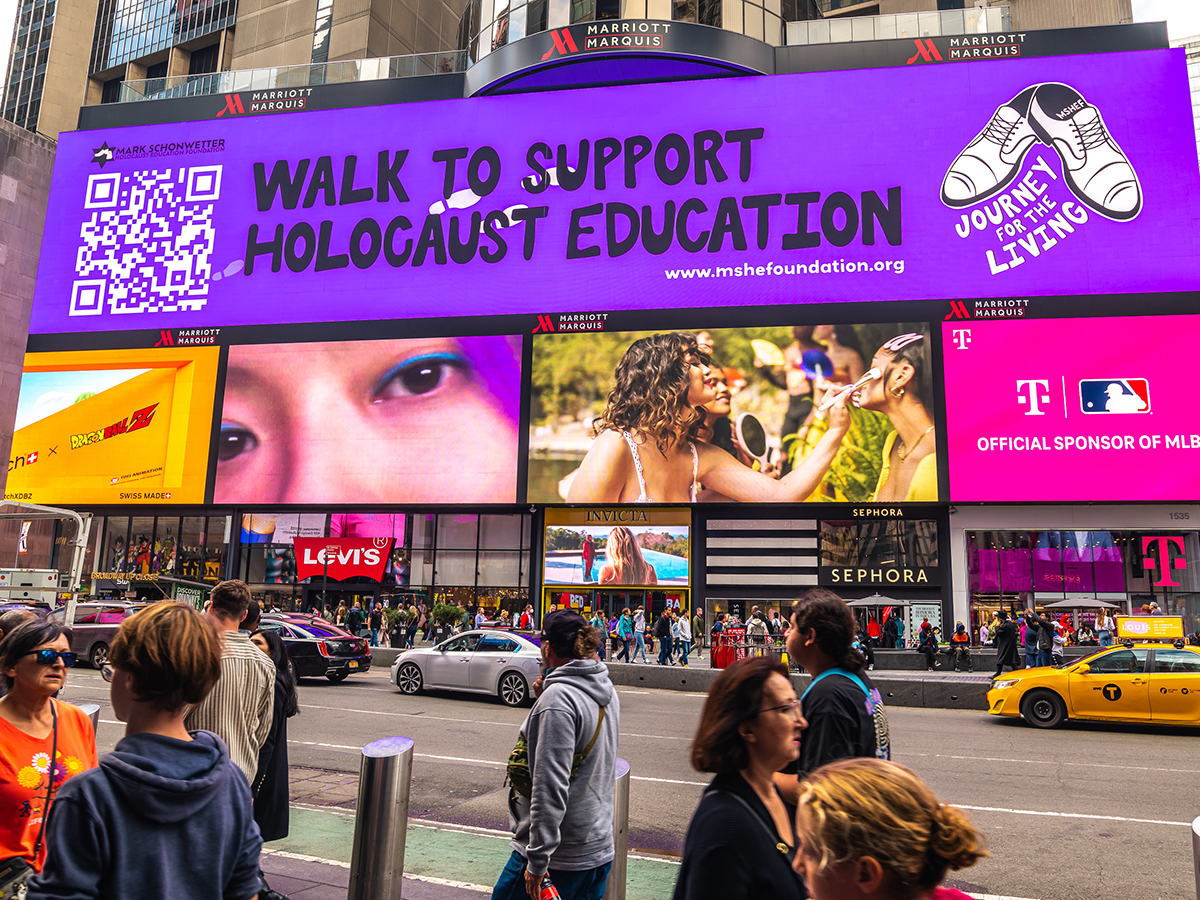Thanks to a cross-campus collaboration, School of Communications students Ian Myers ’23, Melanie Meisner ’23 and Elizabeth Daria ’23 designed a digital billboard for the Mark Schonwetter Holocaust Education Foundation and its charitable initiative, Journey for the Living.
During the month of November, the purple hue of a digital billboard designed by three Elon University students shined across the expansive front of the New York Marriott Marquis, positioned on the south end of the world-famous Times Square.
The city-block-wide graphic couldn’t be missed, but the thousands of passersby likely had no idea of its connection to Elon. Though they can hardly be blamed. There was no maroon and gold, nor a phoenix or even a branded acorn in sight.
Yet, it was very much an Elon collaboration.
The billboard was created as a joint effort by Ian Myers ’23, Melanie Meisner ’23 and Elizabeth Daria ’23 – all three majoring in communication design – in support of the Mark Schonwetter Holocaust Education Foundation and its charitable run to raise awareness and educational funding. In a one-of-a-kind font created by Meisner, the enormous billboard read, “Walk to Support Holocaust Education.” To the right were a pair of shoes and the text, “Journey for the Living.” Tiptoeing in the background were footprints to give the sign a sense of movement.
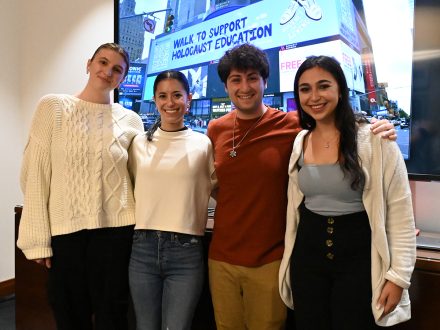
The massive advertisement, which launched on Nov. 1 and ran through the end of the month, came to fruition because of several relationships on Elon’s campus. It was an endeavor that loops through the Doherty Center for Creativity, Innovation & Entrepreneurship and the Department of Communication Design, connecting one student’s good idea with three others with the creativity to bring it to life.
For Myers, the project’s objective was appealing far beyond the opportunity to have his work displayed in one of the world’s most famous locations. The project felt – and was – deeply personal.
“As a Jewish American I have personal connections with the Holocaust and am directly affected by ‘uneducation’ surrounding the Holocaust,” said Myers, who serves as president of the Elon Hillel. “When the opportunity to create this billboard and to promote this great foundation came about, I was all in to promote their important message.”
15 miles to escape
As a young Jewish boy in Brzostek, Poland, Mark Schonwetter – for whom the foundation is named – survived the Holocaust under the direst of circumstances. After his father was taken by the Nazi Gestapo, Schonwetter fled with his mother and younger sister, walking 15 miles in a single night to escape. Over the next three years, and until the end of the war, his family hid in the homes of kind Polish families and the surrounding forests.
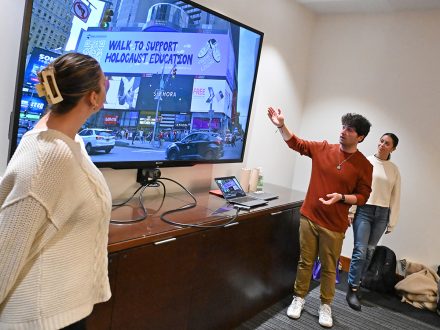
In recent years, Schonwetter and his daughters, Ann Arnold and Isabella Fiske, have shared their family’s heroic story. The family has published a book, hosted speaking engagements and established the Mark Schonwetter Holocaust Education Foundation to fund school programs that enhance Holocaust curriculum.
Lexi Arnold ’23, daughter of Ann Arnold and granddaughter of Mark Schonwetter, is an Elon senior majoring in entrepreneurship and a scholar intern with the Doherty Center. And it was her idea to have Elon students create a Times Square billboard for her family’s foundation. As only a daughter can do, Lexi Arnold told her mother that the previous year’s design looked underwhelming. This led to a conversation with Arnold and Alyssa Martina, who directs the Doherty Center, about a possible Elon student competition to select a new billboard design. Martina then turned to her colleagues in the School of Communications for direction.
“All of the professors I contacted were amazingly supportive of this idea,” Martina said, “but Ben Hannam pointed out that there might not be sufficient time for a competition since our window was quite tight. So, he suggested that we identify specific students to work with Lexi and the foundation. And he was right.”
According to Hannam, several students showed interest in the project, with Daria, Meisner and Myers ultimately teaming up. As it turned out, Daria is also a Doherty Center scholar intern, “so there was a lot of synergy between our programs and the school,” Martina noted.
Hannam said it wasn’t a coincidence that Myers was recommended given his Hillel presidency, but the associate professor also saw the billboard as a perfect professional development opportunity. “This project hit a sweet spot for Ian because it provides him with an opportunity to talk about his leadership participating in Elon Hillel and collaborating and leading a team in a rather unique project that would be displayed for thousands,” the professor said.
For Meisner, who is Jewish, her involvement stemmed from a place of appreciation for her teachers and educators who discussed the Holocaust as part of her public school curriculum in New Jersey. Those important conversations as a youngster allowed her to “truly appreciate how important it is to spread awareness,” she said. Additionally, the project provided Meisner with a place to convey her feelings in a visual form.
“I often turn to art to help me cope and spread awareness about the things bothering me in society,” Meisner said. “The opportunity to design an ad for Journey for the Living for the largest billboard in Times Square helped me understand how my work is making a difference to create a better-educated community when it comes to knowledge and remembrance of the Holocaust.”
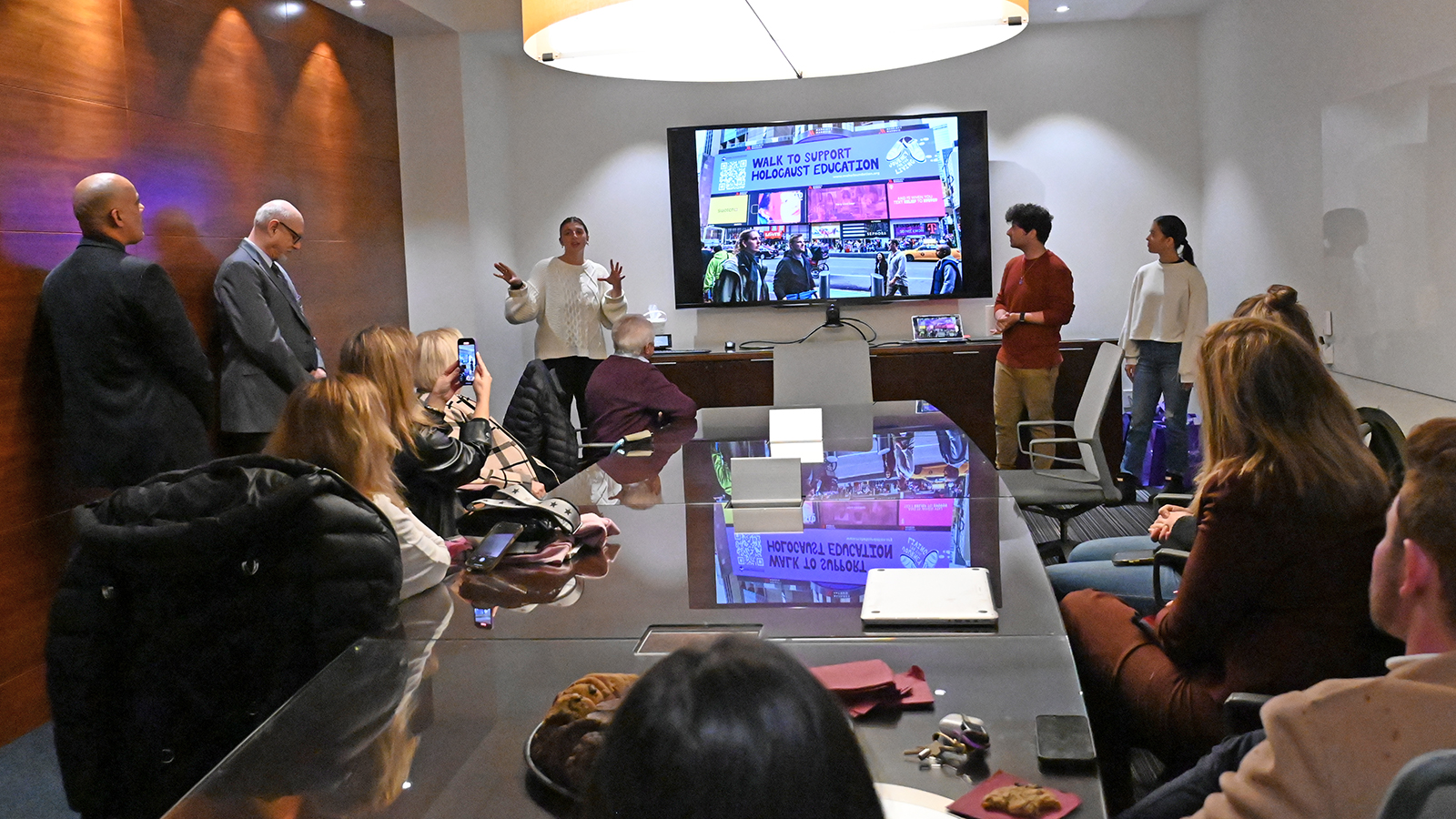
‘Bad drafts’ lead to great design
Before the design process could begin, introductions had to be made.
To kick off the project this fall, the student design team held video meetings with Schonwetter, his two daughters and his granddaughter to get a sense of their vision, their expectations and what past versions of the billboard and graphics looked like. The three design students then spent weeks brainstorming, designing, collecting critiques from professors and redesigning until they landed on a final version.
“We created a ton of what we called ‘bad drafts’ that we shared with the foundation,” Daria quipped. “These were drafts that we knew had solid pieces to them, but were not anywhere near ready to be up in Times Square.”
The students worked to create design elements – redesigned logos, possible layouts and motion graphics – that “we felt would make the billboard pop,” Myers added.

The multiple meetings with the foundation and subsequent feedback allowed the students to understand the valuable insights of previous design choices. “We learned that the logos were built with intention because of a powerful story of remembrance, which we made sure to keep in the redesigned logos that we built,” Myers said. “While it took a lot of time … the final product was better than we could have imagined.”
Hannam recalls that he and Myers met informally throughout the semester to discuss the project’s status. At one point, the duo sketched out a proposed layout on a 4-foot by 16-foot whiteboard. The mock-up allowed the student and professor to take a step back and visualize the board – albeit without thousands of tourists milling about.
According to Myers, the students were confronted with two overarching challenges with their project. First, the sign had to deliver its information quickly – the board rotates every 15 seconds. The second obstacle was identifying ways to grab people’s attention in a crowded environment. As part of their research, the students learned that most successful billboards use motion and, so, they incorporated walking footprints in the background.
“I built these three sets of walking footprints in Adobe After Effects to represent the 15 miles walked by Mark and his family members while also using the motion to grab the viewer’s eyes,” Myers said.
Hannam called Meisner’s illustrated shoes one of his favorite parts of the project. Early concepts featured running and walking shoes – in reference to the Journey for the Living running/walking challenge – but the professor didn’t sense it fit the foundation’s story.
“What I like most about the shoes Melanie illustrated was that she chose shoes that represented ‘the community’ rather than ‘athletics,’” Hannam said. “A poetic and insightful design decision that might go unnoticed, but it added a subtle layer of visual information that reinforces their concept beautifully.”
Hannam also appreciated the students’ utilization of a QR code so that passersby could connect with the initiative quickly and easily. “Who doesn’t go into Times Square without their phone and camera?” he noted.
On the biggest of screens
Two weeks after the billboard’s launch – which Ann Arnold captured on Facebook Live –Schonwetter and his family were officially introduced to the student designers during an unveiling celebration on Nov. 15 in Dwight C. Schar Hall.
Chronologically, the launch and unveiling are a bit out of order, but it didn’t temper the joyful mood in the conference room. Schonwetter’s campus visit also included a public lecture for the Elon community.
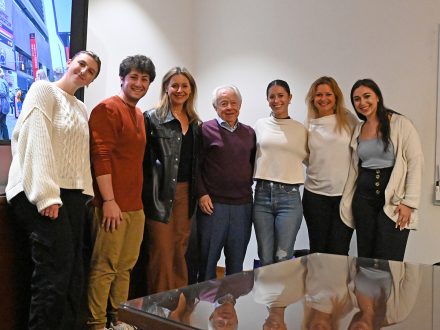
As it were, the three student designers did not see the billboard live in person. Instead, on the day of the billboard’s first public appearance, Myers and Hannam resorted to a web camera positioned on Times Square. “Luckily, the Elon network was able to spring into action since, and the team received some great photos and videos of the billboard in action,” Hannam said.
“I am very proud of our final design,” Myers said. “It was an incredible feeling that my work was being shown in New York City to thousands of people. It also brought me a sense of pride as a Jewish person to promote this important education.”
Admittedly, the group said it was an emotional project given its content and meaning. However, they took solace in each other’s support.
Meisner said she relished the collaborative nature the design trio had, and how they aligned their skills to “create something we could all be proud of.” Myers appreciated the different perspectives his partners contributed, leaning on one another to make the most appealing billboard they could.
Hannam expressed his thanks to Martina, the Doherty Center and the Mark Schonwetter Holocaust Education Foundation for seeking out the School of Communications, collaborating with the students, and serving as both a client and as a partner.
“I think this was a highly successful, sometimes stressful project that epitomizes Elon’s mantra of engaged learning and community involvement,” Hannam said. “I’m proud of the solution that our students were able to produce – a design worthy of the bright lights of Times Square.”



